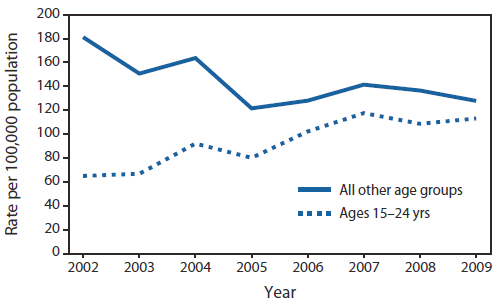Is
Hepatitis C Rising among Young People?
SUMMARY
Massachusetts surveillance data showed an increase in hepatitis
C among adolescents and young adults during 2002-2009, thought
to be largely attributable to injection drug use. |
By
Liz Highleyman
Hepatitis
C virus (HCV) infection and resulting liver disease is most
prevalent among baby boomers, but a recent study found evidence
that the number of infected adolescents and young adults may be
rising in the U.S., according to a report in the May
6, 2011, Morbidity and Mortality Weekly Report.
Researchers with the Massachusetts Department of Public Health (MDPH)
and the Centers for Disease Control and Prevention (CDC) described
findings from a Massachusetts surveillance initiative to collect
more detailed information about hepatitis C cases reported during
2007-2009 among people in the 15-24 year age group.
Nationwide, rates of symptomatic acute HCV infection declined during
1992-2005 and then began to level off, the study authors noted as
background. Rates of newly reported HCV infection in Massachusetts
also declined overall during 2002-2006, but an increase was seen
in the 15-24 age group.
Results
 |
The
surveillance initiative revealed continued increases in newly
reported HCV infections among people age 15-24 years. |
 |
During
2002-2009, the rate of newly reported confirmed and probable
HCV infections in this group increased from 65 to 113 cases
per 100,000 people. |
 |
During
2007-2009, MDPH received 1925 reports of new HCV infections
among people age 15-24 years, of which 1026 (53%) were confirmed. |
 |
Most
newly reported infections (78%) occurred among non-Hispanic
whites, and were distributed equally between men and women.
|
 |
New
cases were reported from all areas of the state, including large
metropolitan areas, suburbs of Boston, smaller cities, and rural
areas. |
 |
8%
of new infections with complete case report forms occurred among
homeless or incarcerated people. |
 |
Current
or past injection drug use was the most common HCV transmission
risk factor, reported by 72%. |
 |
Among
injection drug users, 85% reported heroin use, 29% cocaine use,
1% methamphetamine use, and 4% other drugs (some used more than
1 drug). |
 |
34%
of newly infected people reported a history of nasal drug use,
but most of them also reported injecting drugs, making the transmission
route uncertain. |
| Rates
of newly reported cases of hepatitis C virus infection
(confirmed and probable) among persons aged 15--24 years
and among all other age groups --- Massachusetts, 2002--2009
|
|
 |
"The
increase in case reports appears to represent an epidemic of HCV
infection related to [injection drug use] among new populations
of adolescents and young adults in Massachusetts," the researchers
concluded. "The findings indicate the need for enhanced surveillance
of HCV infection and intensified hepatitis C prevention efforts
targeting adolescents and young adults."
"Although calculating an incidence rate from the surveillance
data or determining the duration of infection for persons who tested
positive for anti-HCV antibody is not possible, the findings suggest
that most persons aged 15-24 years with HCV infection likely acquired
their infections within a few years of being tested and reported,"
wrote the authors of an editorial note accompanying the report.
During this period of increasing HCV infection, Massachusetts also
experienced a corresponding increase in heroin use among adolescents
and young adults (based on records from substance abuse programs),
while the rate of reported injection drug use among other age groups
remained relatively constant
"Although similar increases in [HIV] infection were not identified
for this age group, increases in reports of HCV infection among
injection drug users might be a harbinger of increases in IDU-associated
HIV," they added. HCV is more easily transmitted than HIV,
and infection with the former typically occurs sooner after a person
starts injecting drugs.
This report "strongly indicates the need for expanded and intensified
hepatitis C prevention efforts targeting adolescents and young adults,"
the editorial authors concluded. "Some interventions that could
be implemented include access to sterile syringes and drug preparation
equipment through syringe exchange services, expanded school-based
education that includes viral hepatitis prevention messages, expanded
harm reduction programs directed toward young drug users, entry
to drug treatment for young injection drug users, and access to
comprehensive health services that include HCV testing and linkage
to care."
Investigator affiliations: Massachusetts Dept. of Public Health,
Boston, MA; Division of Viral Hepatitis, National Center for HIV/AIDS,
Viral Hepatitis, STD, and TB Prevention, CDC, Atlanta, GA.
5/13/11
Reference
S
Onofrey, D Church, P Kludt, et al. Hepatitis C virus infection among
adolescents and young adults -- Massachusetts, 2002--2009. Morbidity
and Mortality Weekly Report 60(17):537-541 (free
full text). May 6, 2011.
|
